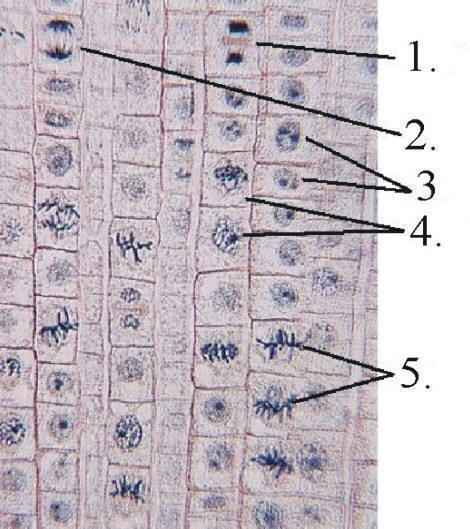ANSWER KEY TO THE MITOSIS HANDOUT ASSIGNMENT
The following figure gives you the name of various stages of the cell cycle for a plant cell. Interphase not actually a part of the nuclear division know as mitosis but represents the visual appearance of the nucleus prior to and after mitosis. Note the differences among the various stages of mitosis (i.e., Prophase, Metaphase, Anaphase, and Telophase). You will use this information to help you address most of the questions that follow. For additional information refer to your textbook, especially Figures 8-2, 8-5, 8-6, and 8-10 on pages 151, 155, 156, and 160 in your textbook “Asking About Life” by Tobin & Dusheck.
1. Of the four cells of onion seen in the following figure, what phases of the cell cycle are seen? What are the dark objects seen in the center of the intact nuclei?

Three nuclei are in interphase and the upper right cell is in telophase.
- What phase of mitosis is represented in the following picture?

Anaphase
3. Of the two cells of onion seen in the following figure, what phases of the cell cycle do you observe?
Upper cell is in metaphase and lower cell is in telophase.
- Of the cells of onion seen in the following figure, match the particular phase of the cell cycle that the line is pointing to with the list given off to the right of the picture.

____2.___ A. Anaphase
____4___ B. Prophase
____5.___ C. Metaphase
____1.___ D. Telophase
___ 3.____ E. Interphase
6. Base on the figure to the left, what phase of the cell cycle appears to be the most common? Metaphase and Interphase.
7. Visit http://www.tvdsb.on.ca/westmin/science/sbi3a1/Cells/Osmosis.htm, which is available on the internet. Based on what we discussed in class and the information available at this web site, what would happen to a human cell if it were placed in a hypertonic environment? It would shrink due to water loss.
8. Write out the definition for the following terms: simple diffusion, osmosis, tonicity, isotonic, hypotonic, and hypertonic.
-
Simple Diffusion is the spontaneous spreading of something such as particles, heat, or momentum. The phenomenon is readily observed when a drop of colored water is added to clear water, or when smoke from a chimney dissipates into the air. In these cases, diffusion is the result of turbulent fluid motion rather than chemical reactions or the application of external force. In cell biology, diffusion is described as a form of "passive transport", by which substances cross membranes.
-
Facilitated Diffusion is similar to simple diffusion in that it does not require energy by the cell; ions and molecules move down an electrochemical gradient from a region of high to low concentration. Materials (such as glucose, potassium ions) move across the cell membrane barrier with the assistance of carrier and channel proteins associated in the membrane.
-
-
Osmosis is the net movement of water across a selectively permeable membrane driven by a difference in solute concentrations on the two sides of the membrane.
-
Tonicity - The osmotic pressure or tension of a solution.
-
An isotonic environment occurs when an equal solute concentration exists between two systems of aqueous solutions.
-
A hypotonic solution with a lower concentration of solutes than compared to another solution. In a hypotonic environment, osmosis causes water to have net flow into the cell, causing the swelling and expansion of the cell. A hypertonic solution with a higher concentration of solutes than compared to another solution. In a hypertonic environment, osmosis causes water to have net flow out of the cell, causing the shrinking of the cell.
Also refer to the glossary in textbook or reading assignments (given on syllabus) in the textbook.